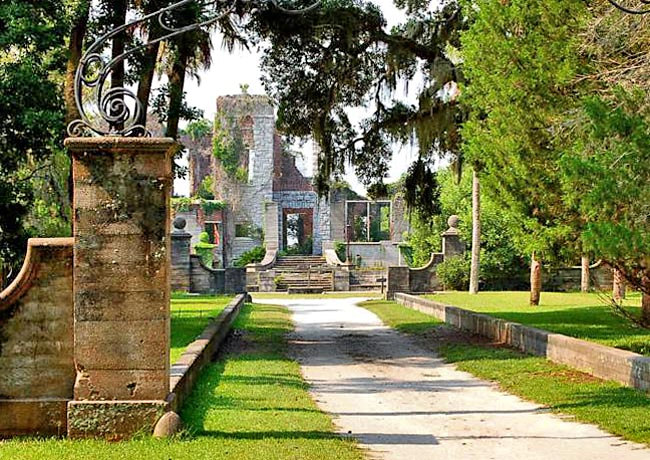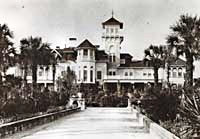|
Scenic USA - Georgia Dungeness Mansion Ruins |

| Photo by Rick George Inset photo courtesy of NPS |
Georgia's Cumberland Island, just off the southern coast, has undergone significant changes over the past 400 years. American Natives enjoyed the island's rich hunting and fishing grounds for hundreds of years before the Spanish arrived in 1566. Land was cleared, forts were built and missions were founded during Spanish occupation. By the 1700s the Spanish moved southward, and England's General James Oglethorpe arrived on Cumberland Island. Here, he erected Fort William. He also established a hunting lodge that he named Dungeness after a headland in his native land of England. During the mid 1700s southern Georgia became a military buffer hoping to protect Britain's southern colonies from a Spanish military presence in St. Augustine, Florida. Oglethorpe's troops repelled two Spanish attacks, helping to persuade Spanish commanders to withdraw to St. Augustine.
After the American Revolution, island plantation owners cleared more land, sold the timber, planted crops and raised livestock.  Revolutionary war hero, General Nathaniel Greene had a grand idea for his own mansion on Cumberland Island. After his death, Greene's wife carried out the plan of the new Dungeness, a large four story tabby mansion. During the Civil War, the home was destroyed by fire, but soon became the home site for Thomas M. Carnegie, brother of the famous industrialist Andrew Carnegie. The third Dungeness home, much grander than the second, was completed after Carnegie's death in 1886. The Queen Anne style mansion was built with 54 rooms, out-buildings for a staff of 200, a golf course and pool. Even though the Carnegie family owned nearly 90 percent of the island, their interest waned by 1925 and during the Depression Era the mansion fell into disrepair. After a suspicious fire in 1959 the mansion was basically destroyed. In 1972 the site was deeded over to the National Parks Service.
Revolutionary war hero, General Nathaniel Greene had a grand idea for his own mansion on Cumberland Island. After his death, Greene's wife carried out the plan of the new Dungeness, a large four story tabby mansion. During the Civil War, the home was destroyed by fire, but soon became the home site for Thomas M. Carnegie, brother of the famous industrialist Andrew Carnegie. The third Dungeness home, much grander than the second, was completed after Carnegie's death in 1886. The Queen Anne style mansion was built with 54 rooms, out-buildings for a staff of 200, a golf course and pool. Even though the Carnegie family owned nearly 90 percent of the island, their interest waned by 1925 and during the Depression Era the mansion fell into disrepair. After a suspicious fire in 1959 the mansion was basically destroyed. In 1972 the site was deeded over to the National Parks Service.
Today, majestic oaks and native scrub habitat have returned, offering visitors a more natural looking coastal island. The Dungeness ruins, pictured here, present a stirring site on Cumberland Island National Seashore.
Area Map

|
More Area Attractions |
|
Copyright © 2024 Benjamin Prepelka
All Rights Reserved
